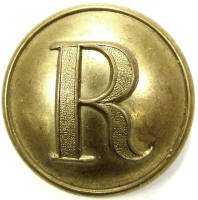
A virtual examination of artifacts of the American Civil War
 |
Ridgeway Civil War Research Center, A virtual examination of artifacts of the American Civil War |
| Civil War Artillery | |
| by Harry Ridgeway |
| Rifled artillery projectile, Schenkl design, Federal manufacture, bursting shell, "common" (standard), long pattern, paper sleeve sabot, Schenkl percussion fuze, Parrott 20 pounder rifle, 3.67 in. Projectile was manufactured in the Federal arsenals, following the design of John P. Schenkl. The sabot system consisted of a "forcing cone" paper sleeve, which was intended to expand into the rifling, then flutter away on release. Problems with the paper absorbing moisture or swelling and blocking passage of the flame on firing rendered it impractical with time fuzes and so it saw limited application. This long pattern was intended for the Parrott 20 pounder and has six grooved ribs to secure the sabot. Usually this pattern is a "common" or standard round and will not be filled with balls , and with a percussion fuze it was designed to detonate after striking enemy cannon or equipment. Fuze employed was a Schenkl Army percussion fuze , removable cap had a slider and percussion cap, head is 1.22in.or 1.25in., 10 threads per inch, marked "JP SCHENKL / PAT OCT 16 1861", Jones pg. 98 or 99., top of the fuze hole is milled flat. Projectile measures: diameter 3.6in., length 11.6in. (excluding the fuze), weight 18lbs. Research Center: Artillery5335-Schenkl, Ref: Dickey & George, Field Artillery (1993 Edition), pg. 309. Details click: http://relicman.com/artillery/Artillery5335-Schenkl.html. |
| Ridgeway Civil War Research Center, A virtual examination of artifacts of the American Civil War. Artillery Research center, artillery, click: http://relicman.com/artillery/Artillery0000-Index.html. Research center, artillery, click: http://relicman.com/artillery/Artillery0000-Index.html. |
| Civil War Relicman, Harry Ridgeway, Civil War artillery, Relicman sales catalog. Click here: http://relicman.com/artillery/RelicmanSalesArtillery1.html. Artillery for sale: http://relicman.com/artillery/RelicmanSalesArtillery1.html. |